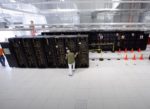A good mid-spring morn to you! You’re invited to join Shahin and Doug on a jaunt (6:04) through recent HPC-AI developments, including: AI infra-tech’s booming costs and data center scarcity problems, a possibe AI bubble ….
HPC News Bytes 20240429: Exorbitant AI Infra-Tech, Advanced Chips in China, Neuromorphic HPC, an AI Bubble?
Sandia Selects SoftIron File and Object Storage for Stria Cluster
Sandia National Laboratories Vanguard program has selected SoftIron, Ltd., to provide supplemental file and object storage for Sandia’s ARM-based Stria high performance computing cluster.
Stria supports the petascale Astra supercomputer – which Sandia said is the fastest ARM-based system on the TOP500 listing of the world’s most powerful computers – as a development system for preparing software releases and codes to be used on Astra.
Time Lapse Video: Building the Attaway Supercomputer at Sandia
In this time lapse video, technicians build the new Attaway supercomputer from Penguin Computing at Sandia National Labs. In November 2019, the Attaway was #94 on the TOP500 Supercomputers list. “On February 28, 2019, Sandians lost a long-time colleague and friend, Steve Attaway. Steve spent over thirty years at Sandia, and during that time he helped bring big, seemingly impossible ideas into realization. The Attaway supercomputer is named after him.”
Using Magnetic Circuits for Energy Efficient Big Data Processing
Researchers at the Cockrell School of Engineering at The University of Texas at Austin have found a way to make the new generation of smart computers more energy efficient. “Traditionally, silicon chips have formed the building blocks of the infrastructure that powers computers. But this research uses magnetic components instead of silicon and discovers new information about how the physics of the magnetic components can cut energy costs and requirements of training algorithms — neural networks that can think like humans and do things like recognize images and patterns.”
Podcast: Accelerating the Adoption of Container Technologies for Exascale Computing
In this Let’s Talk Exascale podcast, Andrew Younge from Sandia National Laboratories describes the new SuperContainers project, which aims to deliver containers and virtualization technologies for productivity, portability, and performance on the first exascale computing machines are planned for 2021. “Essentially, containers allow you to encompass your entire environment in a simple and reproducible way,” says Younge. “So not only do I have my container image that has my application and my entire software stack with it, I also have a manifest for how I got there. That’s a really important notion for many people.”
Super cooling unit saves water at Sandia HPC data center
A new high efficiency cooling unit installed on the roof of Sandia National Laboratories’ supercomputer center saved 554,000 gallons of water during its first six months of operation last year, says David J. Martinez, engineering project lead for Sandia’s Infrastructure Computing Services. “The dramatic decrease in water use, important for a water-starved state, could be the model for cities and other large users employing a significant amount of water to cool thirsty supercomputer clusters springing up like mushrooms around the country, says Martinez.
Purdue University to open Scalable Open Laboratory for Cyber Experimentation
Purdue University’s CERIAS Center for Education and Research in Information Assurance and Security has announced the addition of a new laboratory facility that dramatically increases Purdue’s cyber-physical research, emulation, and analysis capabilities. “This new laboratory is a mirror of the facilities already within Sandia National Labs that have served as the platform for joint CERIAS and DOE research since 2017,” said Theresa Mayer, executive vice president for research and partnerships at Purdue University. “The opening of SOL4CE at Purdue allows us to increase both the speed and impact of our national security research collaboration with Sandia National Labs.”
Exascale Computing Project Announces Staff Changes Within Software Technology Group
The US Department of Energy’s Exascale Computing Project (ECP) has announced the following staff changes within the Software Technology group. Lois Curfman McInnes from Argonne will replace Jonathan Carter as Deputy Director for Software Technology. Meanwhile Sherry Li is now team lead for Math Libraries. “We are fortunate to have such an incredibly seasoned, knowledgeable, and respected staff to help us lead the ECP efforts in bringing the nation’s first exascale computing software environment to fruition,” said Mike Heroux from Sandia National Labs.
Podcast: Sciencetown Investigates Extreme Computing at SC19
In this Sciencetown podcast, we follow experts from around the world to the epicenter of supercomputing – the annual, North American supercomputing conference or SC19. We ask them to weigh in on how the future of computers, artificial intelligence, machine learning and more are coming together to shape the way we explore and understand our world.
Podcast: PSIP Brings Software Development teams together at the Exascale Computing Project
In this Lets Talk Exascale podcast, Elaine Raybourn from Sandia National Laboratories decribes how Productivity Sustainability Improvement Planning (PSIP) is bringing software development teams together at the Exascale Computing Project. PSIP brings software development activities together and enables partnerships and the adoption of best practices across aggregate teams.













